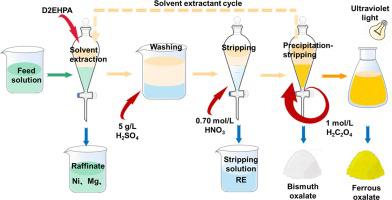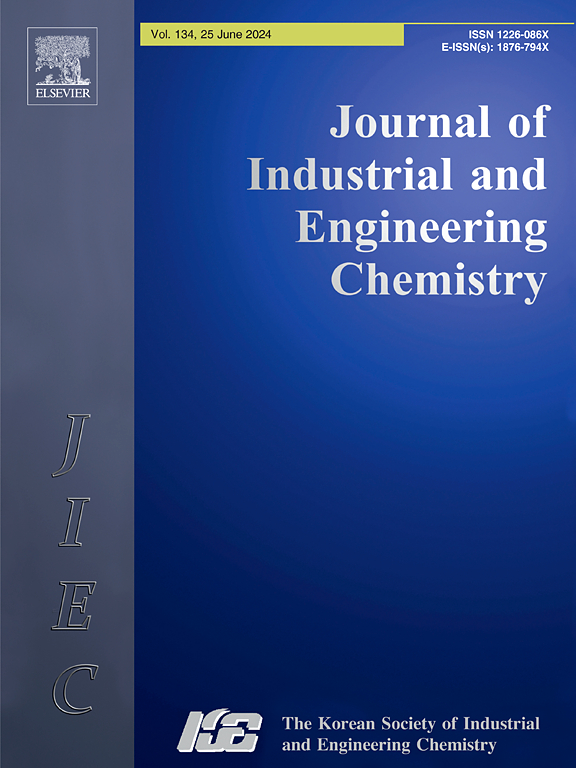通过一步萃取和两步剥离实现稀土、铋和铁的高效分离和综合回收
IF 5.9
3区 工程技术
Q1 CHEMISTRY, MULTIDISCIPLINARY
Journal of Industrial and Engineering Chemistry
Pub Date : 2025-01-25
DOI:10.1016/j.jiec.2024.06.024
引用次数: 0
摘要
提出了一条通过一步萃取和两步剥离从含镍和镁的溶液中分离铋、铁和稀土元素的路线。首先,使用皂化二(2-乙基己基)磷酸(D2EHPA)作为萃取剂分离目标元素。可以从 Ni(II) 和 Mg(II) 中分离出 RE(III)、Bi(III) 和 Fe(III),萃取效率超过 99%。其次,硝酸和草酸分别对 RE(III)、Bi(III)和 Fe(III)进行了选择性剥离。随后,将草酸剥离液中的铁在紫外线照射下处理 15 分钟,以回收草酸并获得草酸亚铁产物。在四级逆流汽提法中,RE(III)、Bi(III)和Fe(III)的汽提效率高达100%,RE(III)和Bi(III)的回收率分别为97.3%和99.2%。硝酸稀土富集液、草酸铋和草酸亚铁的纯度分别为 99.7%、98.4% 和 99.5%。此外,萃取动态表明,当萃取时间超过 7 分钟时,萃取过程中未出现双盐沉淀,并采用斜率法分析了萃取机理。该工艺缩短了步骤,能更有效地从含 Ni(II) 和 Mg(II) 的混合溶液中分离出 RE(III)、Bi(III) 和 Fe(III),具有工业应用前景。本文章由计算机程序翻译,如有差异,请以英文原文为准。


Efficient separation and comprehensive recovery of rare earth, bismuth and iron by one-step extraction and two-step stripping
A route was proposed to separate bismuth, iron, and rare earth elements from a solution containing nickel and magnesium through one-step extraction and two-step stripping. Firstly, saponified di-(2-ethylhexyl) phosphoric acid (D2EHPA) was used as the extractant to separate target elements. RE(III), Bi(III), and Fe(III) could be separated from Ni(II) and Mg(II), with extraction efficiencies of more than 99 %. Secondly, RE(III), Bi(III), and Fe(III) were stripped selectively by nitric acid and oxalic acid, respectively. Subsequently, the iron present in the oxalic acid stripping solution was treated under UV irradiation for 15 min to recover oxalic acid and obtain the ferrous oxalate product. The stripping efficiencies of RE(III), Bi(III), and Fe(III) were up to 100 % for four-stage countercurrent stripping, and the recovery rates of RE(III) and Bi(III) were 97.3 % and 99.2 %. The purities of nitrate rare earth enrichment solution, bismuth oxalate and ferrous oxalate were 99.7 %, 98.4 % and 99.5 %, respectively. In addition, the extraction dynamic demonstrated that the double salt precipitation was not observed during the extraction when the extraction time exceeded 7 min and the extraction mechanism was analyzed using the slope method. This process shortens steps, and is more efficient to separate RE(III), Bi(III), and Fe(III) from the mixed solution containing Ni(II) and Mg(II), which has a prospective industrial application.
求助全文
通过发布文献求助,成功后即可免费获取论文全文。
去求助
来源期刊
CiteScore
10.40
自引率
6.60%
发文量
639
审稿时长
29 days
期刊介绍:
Journal of Industrial and Engineering Chemistry is published monthly in English by the Korean Society of Industrial and Engineering Chemistry. JIEC brings together multidisciplinary interests in one journal and is to disseminate information on all aspects of research and development in industrial and engineering chemistry. Contributions in the form of research articles, short communications, notes and reviews are considered for publication. The editors welcome original contributions that have not been and are not to be published elsewhere. Instruction to authors and a manuscript submissions form are printed at the end of each issue. Bulk reprints of individual articles can be ordered. This publication is partially supported by Korea Research Foundation and the Korean Federation of Science and Technology Societies.

 求助内容:
求助内容: 应助结果提醒方式:
应助结果提醒方式:


